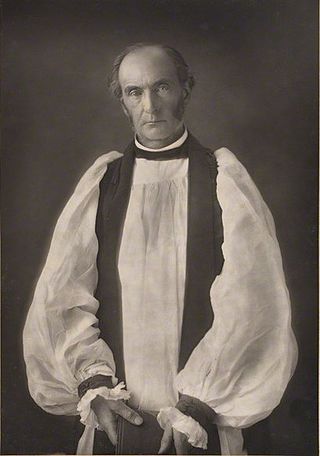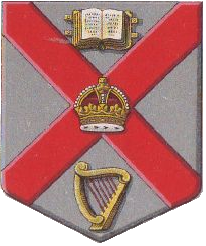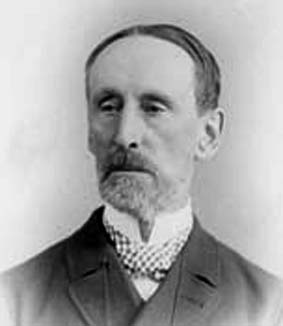Edward Berwick (1804-1877) was an Irish lawyer and educationalist, and served as President of Queen's College Galway from 1849 until 1877. [1]
Berwick was the younger son of the Rev. Edward Berwick (1750-1820), a Church of Ireland clergyman who was rector of the parish of Esker, County Dublin, and later vicar of Leixlip, County Kildare. His mother was Edward's second wife Rebecca Shuldham, daughter of Pooley Shuldham of Ballymulvey, County Longford. [2] Given personal tuition by Dionysius Lardner, he lived with Lardner at Bray and later in Gardiner St. and gave evidence in the divorce case of Heaviside v. Lardner, where Lardner was co-respondent with Mary Spice Heaviside in the action brought by her husband Captain Richard Heaviside.
Educated at Trinity College Dublin, he graduated in law and was called to the Irish Bar in 1832. On the foundation of Queen's College Galway in 1845, Berwick was appointed to the office of Vice-President. [3] The president, Joseph W. Kirwan, died in office in December 1849, and Berwick was appointed to succeed him in 1850. He was mainly an administrator and published very little. [4] He did, however, play a considerable role in structuring the Bachelor of Arts degree, and in establishing history and English literature in the curriculum. [5]
Berwick died in office in 1877. [6]
He was the younger half-brother of Walter Berwick, the Irish Bankruptcy judge, who was killed in the Abergele rail disaster of 1868, along with their sister Elizabeth Mary and a young girl called Louisa Symes, probably a relative, who was travelling with them. [7] Edward is mentioned in a letter from Walter to Lardner in 1828. Edward gave evidence at the accident inquest (see The Times, Thursday, 27 August 1868; pg. 7; Issue 26214; col D The Accident To The Irish Mail Train.)

Professor Dionysius Lardner FRS FRSE was an Irish scientific writer who popularised science and technology, and edited the 133-volume Cabinet Cyclopædia.

Dionysius Lardner "Dion" Boucicault was an Irish actor and playwright famed for his melodramas. By the later part of the 19th century, Boucicault had become known on both sides of the Atlantic as one of the most successful actor-playwright-managers then in the English-speaking theatre. Although The New York Times hailed him in his obituary as "the most conspicuous English dramatist of the 19th century," he and his second wife, Agnes Robertson Boucicault, had applied for and received American citizenship in 1873.

Edward Gibson, 1st Baron Ashbourne, was an Anglo-Irish lawyer and Lord Chancellor of Ireland.

Arthur Edward Guinness, 1st Baron Ardilaun, 2nd Baronet, known as Sir Arthur Guinness, Bt, between 1868 and 1880, was an Irish businessman, politician, and philanthropist, best known for giving St Stephen's Green to the Dublin Corporation for public use.

William Conyngham Plunket, 4th Baron Plunket was Dean of Christ Church Cathedral and Archbishop of Dublin in the Church of Ireland.
Events in the year 1970 in Ireland.

The Queen's University of Ireland was established formally by Royal Charter on 3 September 1850, as the degree-awarding university of the Queen's Colleges of Belfast, Cork, and Galway that were established in 1845 "to afford a university education to members of all religious denominations" in Ireland.
Sir Thomas William Moffett was an Irish scholar and educationalist, who served as president of Queen's College Galway.

Morgan Crofton was an Irish mathematician who contributed to the field of geometric probability theory. He also worked with James Joseph Sylvester and contributed an article on probability to the 9th edition of the Encyclopædia Britannica. Crofton's formula is named in his honour.
The High Sheriff of County Galway was the Sovereign's judicial representative in County Galway. Initially an office for lifetime, assigned by the Sovereign, the High Sheriff became annually appointed from the Provisions of Oxford in 1258. Besides his judicial importance, he had ceremonial and administrative functions and executed High Court Writs.

Edward Percival (Perceval) Wright FRGSI was an Irish ophthalmic surgeon, botanist and zoologist.
William Vitruvius Morrison was an Irish architect, son and collaborator of Sir Richard Morrison.
The High Sheriff of Galway Town was the Sovereign's judicial representative in the county of the Town of Galway. Initially an office for lifetime, assigned by the Sovereign, the High Sheriff became annually appointed from the Provisions of Oxford in 1258. Besides his judicial importance, he had ceremonial and administrative functions and executed High Court Writs.

Nannie Lambert Power O'Donoghue, also known as Ann Stewart Lyster Lambert, was born in 1843 and lived until 12 January 1940. She came from an upper-middle class family and she was famous for her horse riding, poetry and journalism projects. She was a journalist and wrote pieces and articles concerning social welfare and animals well being. She was also a musician, novelist and social activist. She had written many different books, her most famous; Riding for Ladies (1887) sold more than 94,000 copies.
The High Sheriff of Leitrim was the British Crown's judicial representative in County Leitrim, Ireland from c.1582 until 1922, when the office was abolished in the new Free State and replaced by the office of Leitrim County Sheriff. The sheriff had judicial, electoral, ceremonial and administrative functions and executed High Court Writs. In 1908, an Order in Council made the Lord-Lieutenant the Sovereign's prime representative in a county and reduced the High Sheriff's precedence. However the sheriff retained his responsibilities for the preservation of law and order in the county. The usual procedure for appointing the sheriff from 1660 onwards was that three persons were nominated at the beginning of each year from the county and the Lord Lieutenant then appointed his choice as High Sheriff for the remainder of the year. Often the other nominees were appointed as under-sheriffs. Sometimes a sheriff did not fulfil his entire term through death or other event and another sheriff was then appointed for the remainder of the year. The dates given hereunder are the dates of appointment. All addresses are in County Leitrim unless stated otherwise.
The High Sheriff of Longford was the British Crown's judicial representative in County Longford, Ireland from the 16th century until 1922, when the office was abolished in the new Free State and replaced by the office of Longford County Sheriff. The sheriff had judicial, electoral, ceremonial and administrative functions and executed High Court Writs. In 1908, an Order in Council made the Lord-Lieutenant the Sovereign's prime representative in a county and reduced the High Sheriff's precedence. However the sheriff retained his responsibilities for the preservation of law and order in the county. The usual procedure for appointing the sheriff from 1660 onwards was that three persons were nominated at the beginning of each year from the county and the Lord Lieutenant then appointed his choice as High Sheriff for the remainder of the year. Often the other nominees were appointed as under-sheriffs. Sometimes a sheriff did not fulfil his entire term through death or other event and another sheriff was then appointed for the remainder of the year. The dates given hereunder are the dates of appointment. All addresses are in County Longford unless stated otherwise.
The Sheriff of County Dublin was the Sovereign's judicial representative in County Dublin. Initially, an office for a lifetime, assigned by the Sovereign, the Sheriff became an annual appointment following the Provisions of Oxford in 1258. The first recorded Sheriff was Ralph Eure, appointed in that year. The next recorded Sheriff was Sir David de Offington, who was Sheriff in 1282. Besides his judicial importance, the sheriff had ceremonial and administrative functions and executed High Court Writs.
Walter Berwick (1800–1868) was an Irish judge, who perished in the Abergele rail disaster of 1868. He was a much loved public figure, especially in Cork, where he is commemorated by the Berwick Fountain on the Grand Parade in Cork city. He presided over the official inquiry into the Dolly's Brae conflict in 1849.
William St Lawrence, 2nd Earl of Howth was an Anglo-Irish peer, styled Viscount St Lawrence from 1767 to 1801. He was the eldest son of Thomas St Lawrence, 1st Earl of Howth and Isabella King, daughter of Sir Henry King, 3rd Baronet and Isabella Wingfield.
Henry Brocas was an Irish artist known for his landscapes and engravings.